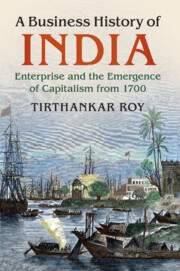Book contents
- A Business History of India
- A Business History of India
- Copyright page
- Dedication
- Contents
- Figures
- Maps
- Tables
- Boxes
- Preface
- 1 Introduction
- 2 The Baseline at 1700
- 3 The Indian Ocean Sphere: 1700–1850
- 4 Capital and Empire (1850–1930)
- 5 Capital and Empire (1850–1930)
- 6 State and Industrialisation: 1930–1950
- 7 State and Industrialisation: 1950–1980
- 8 Revival: 1980–2000
- 9 Capital and Globalisation: 2000–2015
- 10 Conclusion
- References
- Index
2 - The Baseline at 1700
Published online by Cambridge University Press: 20 March 2018
- A Business History of India
- A Business History of India
- Copyright page
- Dedication
- Contents
- Figures
- Maps
- Tables
- Boxes
- Preface
- 1 Introduction
- 2 The Baseline at 1700
- 3 The Indian Ocean Sphere: 1700–1850
- 4 Capital and Empire (1850–1930)
- 5 Capital and Empire (1850–1930)
- 6 State and Industrialisation: 1930–1950
- 7 State and Industrialisation: 1950–1980
- 8 Revival: 1980–2000
- 9 Capital and Globalisation: 2000–2015
- 10 Conclusion
- References
- Index
Summary
The Indian subcontinent is geographically diverse. A big part of it consists of the Indo-Gangetic Basin formed of the floodplains of two huge Himalayan river systems, the Ganges and the Indus (Map 2.1). The Basin has fertile land that in the past sustained cities, armies, trade, crafts, and states. Elsewhere, agricultural conditions were poorer. But the long coastline contained settlements of traders who conducted a lot of maritime trade around and near the Bay of Bengal, especially the Arabian Sea. Such settlements also occurred in the arid fringes of the western deserts, through which important overland trade routes passed. Around 1700, this composite land was ruled by the Mughal Empire (1526–c. 1720) in the Indo-Gangetic Basin, and by smaller states and semi-independent vassals of the Mughals nearer the coast. Although the Empire did possess ports, overall, it had weak penetration into the coastal areas and into the seas.
Therefore, two quite different types of capitalism functioned side by side, with limited interactions between them. One of these formed along the coasts, lived on maritime trade, and was sponsored by the coastal states. The other one formed in the interior, and served overland trade. The main geographical space for land trade was the Indo-Gangetic Basin. Relatively flat terrain, wheeled traffic, navigable rivers, and cities that were home to wealthy consumers, sustained land trade. Where river traffic ended, caravans began. Bullock caravans linked the Indo-Gangetic Basin with the Deccan Plateau where wheeled and river transport were less developed. Small pack animals crossed the Himalayas to link other parts of land-locked Asia with India. The Empire ruled from northern regions in the Indo-Gangetic Basin. The Empire possessed ports like Surat or Hooghly, but the coast was mainly ruled by smaller local states.
Although these two complexes intersected to some extent, they involved different groups of merchants, different goods, different clients, different sponsors, and possibly, different organisation. Land trade carried grain, silk, textiles, wool, horses, precious stones, and other luxury articles consumed by the military-political elite of the Mughal cities. Sea trade carried mainly cotton textiles. Land trade and the financing of land trade involved communities, such as the Khatris and Marwaris, who did not have a significant presence in the ports.
- Type
- Chapter
- Information
- A Business History of IndiaEnterprise and the Emergence of Capitalism from 1700, pp. 22 - 39Publisher: Cambridge University PressPrint publication year: 2018



